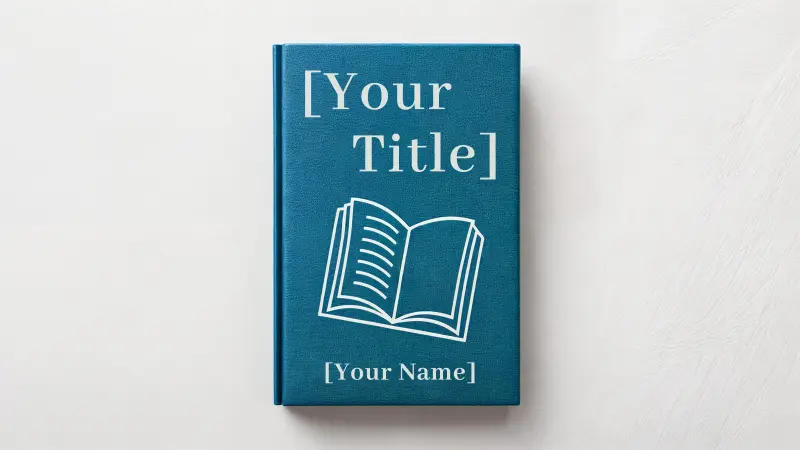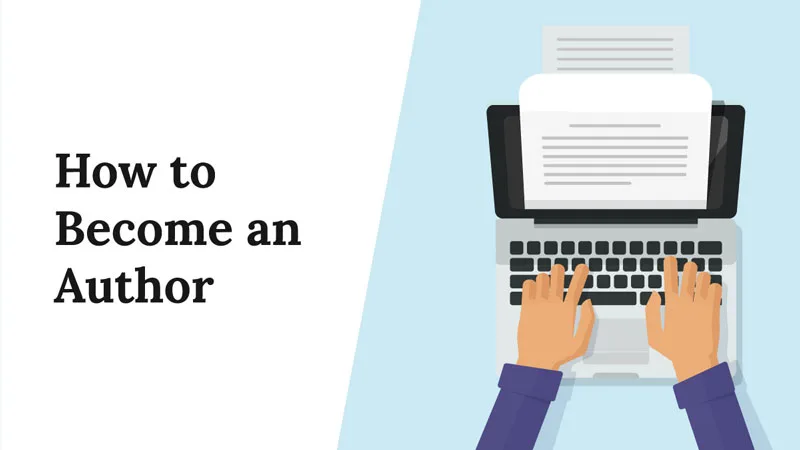How to write a children’s book is a question many aspiring authors ask. Some assume that writing for kids is easier than writing for adults. But as Mark Haddon, author of The Curious Incident of the Dog in the Night-Time, put it, “writing for children is bloody difficult…”
A truly great children’s book is more than just a simple story. It needs to be engaging, age-appropriate, and imaginative—all while maintaining clear language, a meaningful message, and captivating storytelling.
Maybe your inspiration comes from bedtime stories with your little ones or a childhood dream you held onto. No matter where your idea begins, creating a children’s book requires a lot of thought and creativity.
While the advice in this blog post applies to all children’s books, it’s especially useful for those writing board books, picture books, and early readers. Here’s how you can turn your idea into a children’s book.
How to Write a Children’s Book in 10 Simple Steps
Every beloved children’s book started with one small idea—and a plan to shape it into something unforgettable. These nine steps will guide you through the process, from drafting to completing your story.
1. Define Your Target Audience
Before you put pen to paper, you need to know who you’re writing for.
The world of children’s books is vast, ranging from sturdy board books for babies to complex middle-grade novels for preteens. Each category has different expectations, language levels, and styles, so understanding where your book fits is the first step.
Choose Your Age Group
Children’s books are categorized by age.
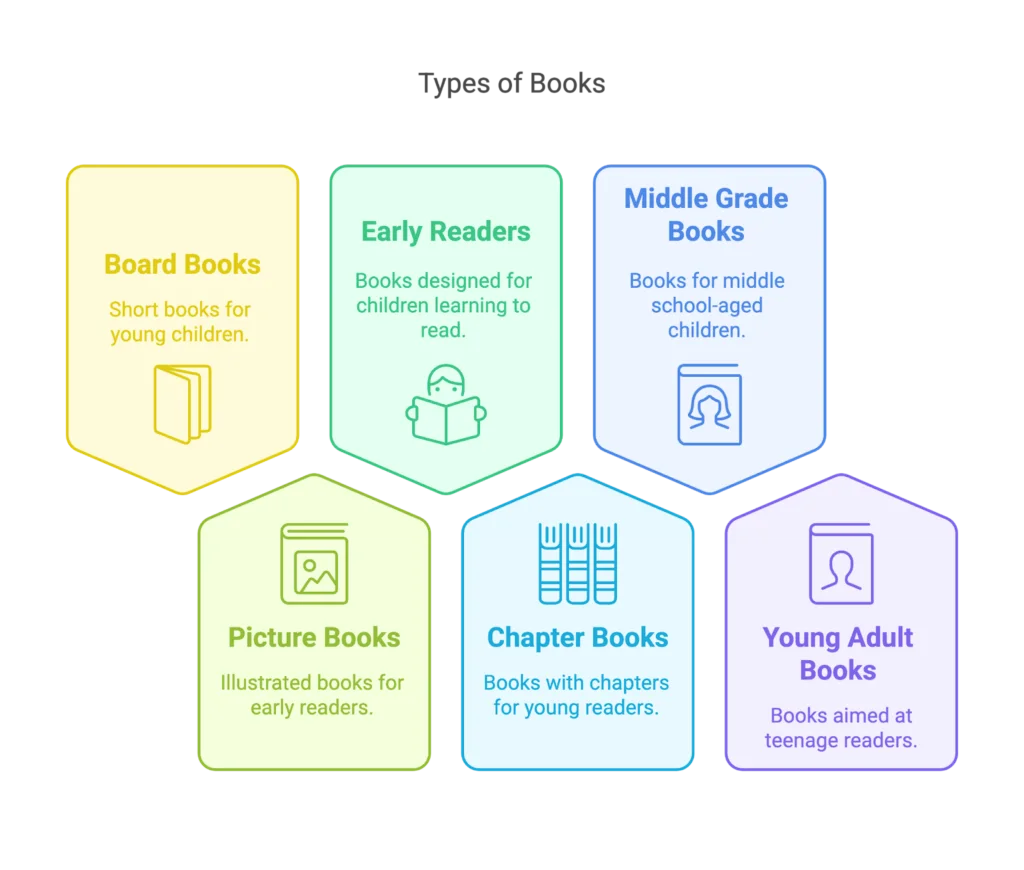
Board Books (Ages 0-3). These are short, sturdy books with simple words and bright pictures. Many incorporate interactive elements like textures, flaps, or mirrors to engage little hands and eyes. They introduce basic concepts like colors, numbers, and animal names.
Picture Books (Ages 3-7). These rely heavily on illustrations to tell a good story. Remember that most children’s books for younger readers thrive on rhythm and repetition, making them fun to read aloud. Think of classics like Goodnight Moon or The Very Hungry Caterpillar. Many picture books also include a moral or lesson.
Early Readers (Ages 5-9). These books are designed for kids starting to read on their own. Sentences are simple, and plots are easy to follow. These books help kids transition from picture books to chapter books while using engaging illustrations.
Chapter Books (Ages 7-10). These books introduce short chapters and have minimal illustrations. The storylines become more complex, and characters experience growth and challenges. These books and the previous often overlap. The difference is based on literacy levels, not strictly age. Examples include Magic Tree House and Junie B. Jones.
Middle Grade (Ages 8-12). These books dive into deeper themes and character development. They often deal with real-world issues, friendships, and adventure. Percy Jackson and The Babysitters Club fall into this category.
Young Adult (YA)(Ages 13-18). Young adult books cover mature themes, from self-discovery to relationships and societal issues. They explore complex emotions and tackle topics like identity, mental health, and social justice. Some examples include The Hunger Games and The Fault in Our Stars.

Understand Your Audience
Writing for kids isn’t just about simplifying language; it’s about replicating their thoughts and imaginations in the form of words. Here are some key tips:
Read books in your target category. Pay attention to tone, structure, vocabulary, and how the story unfolds.
Observe how kids interact with stories. What makes them giggle? What holds their attention? What words or themes do they connect with?
Keep things age-appropriate. A preschooler won’t grasp sarcasm the same way a 10-year-old would, so tailor your writing style accordingly.
Avoid overly complex language for younger readers. Simple, clear sentences work best, especially for board and picture books.
Understand Who Chooses What To Read
While children are the primary audience, parents make the purchasing decisions. They often look for books that are both entertaining and educational. Many parents seek stories that reinforce positive values, promote learning, and spark their child’s imagination—books they’ll be forever grateful to have on their shelves.
Parents are also influenced by recommendations from teachers, librarians, online reviews, and fellow parents. Knowing what resonates with them allows you to create books that appeal to the gatekeepers who decide which stories become bedtime favorites.

2. Decide on Your Book’s Format, Length, and Layout
Children’s books come in many shapes, sizes, and styles, and selecting the right format impacts how readers engage with your book. It also affects the cost and distribution, making it important to explore your options.
Choosing a Format
The right book format, whether hardcover, digital, or interactive, offers various benefits depending on the needs of your audience and your budget.
Board Books vs. Paperback
Board books are durable and visually appealing, making them great for libraries and collectors, but are more expensive to produce. They are the best choice for children ages 0-3. Their thick pages and durability make them tough enough to withstand spills, teething, and enthusiastic page-turning.
Paperbacks are smaller, more affordable, and transportable, making them popular for self-publishing and wide distribution. Kids ages 4 and up often prefer them, as they begin to associate the latter with younger children.
Interactive vs. Traditional
Lift-the-flap, pop-up books, and touch-and-feel elements make reading a fun, hands-on experience for younger readers. These features are costly to produce but add unique value to the book.
Understanding Word Count and Page Length
Getting the word count and page length right makes meeting your readers’ expectations easier. Each category of children’s books follows industry standards, tailored to the developmental stage of its intended audience.
Board books: These books range from 8-24 pages and contain minimal text, with 100 or fewer words per book.
Picture books: They contain 500-1,000 words and span 24-48 pages, with 32 pages being the standard.
Early readers: With 1,000-5,000 words and 32-64 pages, these books use large fonts and simple sentences.
Chapter books: These books range from 5,000-20,000 words and are 80-100 pages long, featuring short chapters.
Middle-grade books: With 20,000-50,000 words and 100-250 pages, they explore more complex storytelling.
Young Adult books: YA novels range from 50,000-100,000 words and are at least 250 pages long, though some can be much longer.
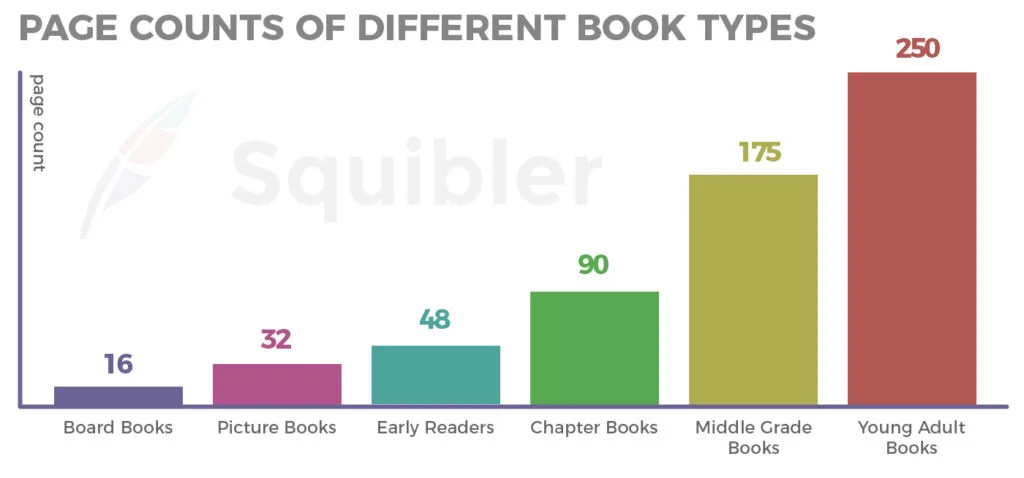
Landing on a Layout
A well-structured book layout enhances readability. Let’s explore the different aspects of a children’s book layout.
Positioning Text and Illustrations
How text and illustrations are combined influences how readers engage with a story. Each book category has unique formatting considerations based on the target age group and reading level.
Board books use full-page illustrations with minimal text. Simple words or short phrases are often placed strategically to complement the artwork.
Picture books rely heavily on illustrations to tell the story. Each page (or spread) is carefully designed to balance text and imagery.
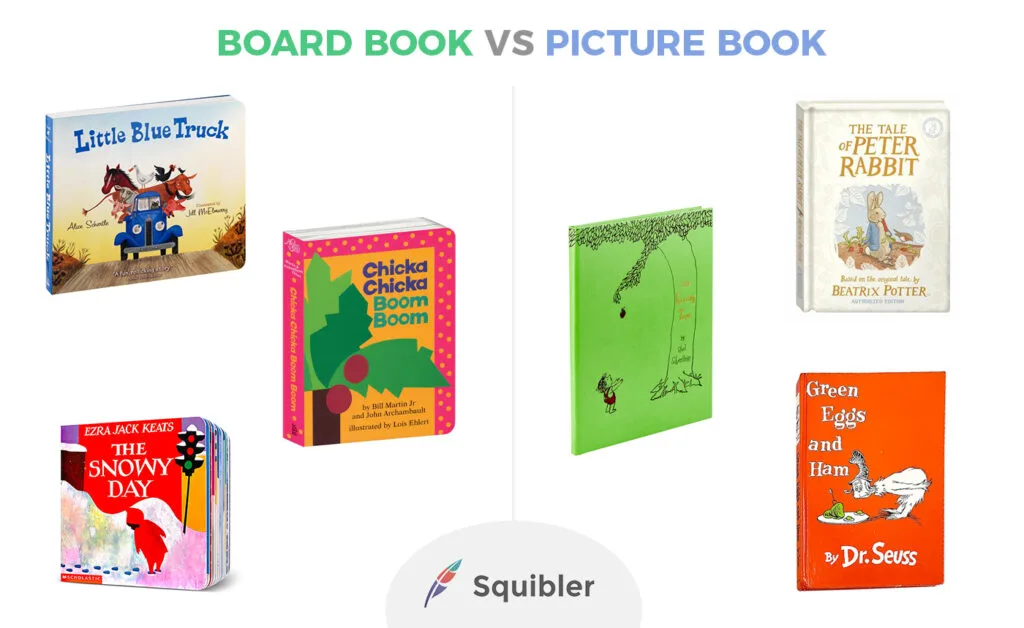
Early reader books feature simple layouts with large fonts, short sentences, and wide spacing. While still including illustrations, they serve a supporting role rather than driving the narrative.
Chapter books have longer text and more complex storylines. They often incorporate black-and-white illustrations that enhance the story without dominating the page.
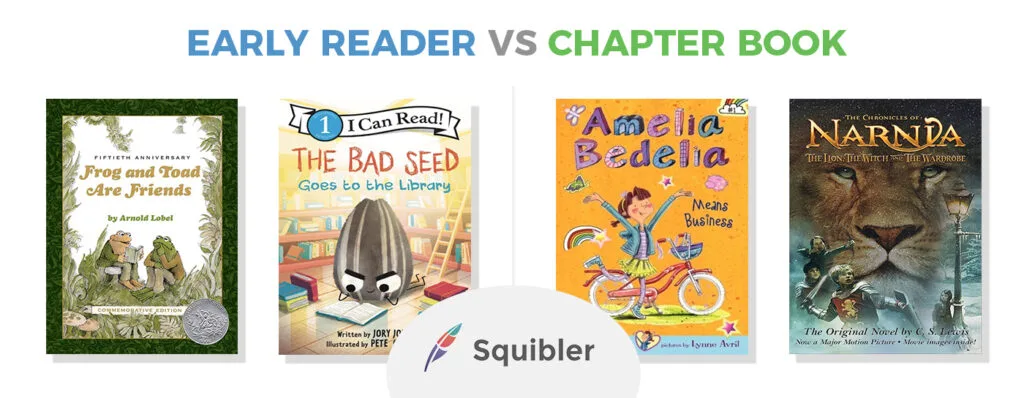
Middle-grade books focus more on text, with little to no illustrations. Young adult books typically follow traditional novel formatting, relying entirely on text to drive the story.
What Size, Shape, and Orientation Is Best?
Choosing the size and shape for your book is also a part of this step. Square books, are ideal for picture books as they provide a large space for vibrant illustrations and allow for an easy-to-hold format.
On the other hand, the classic rectangular shape is better suited for books with more text, such as those for older children and young adults.
Popular formats include 8”x8” for square books, 8.5”x11” for standard picture books, and 5”x8” for chapter books. The right size depends on the target age group and the reading experience you want to create.
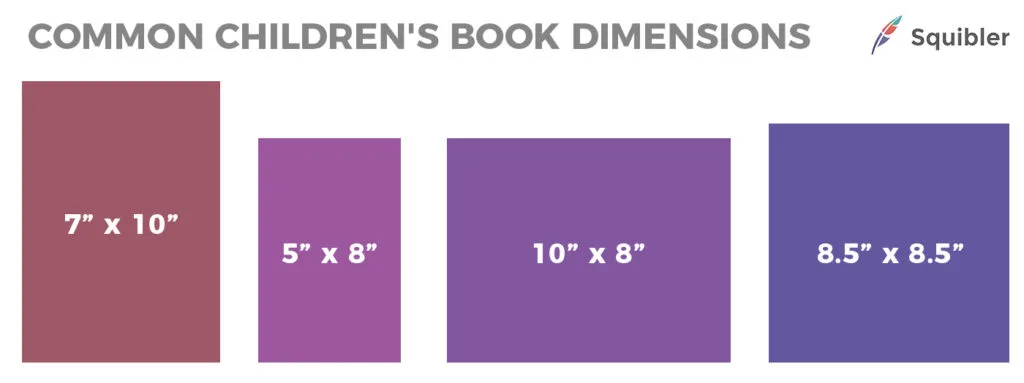
The orientation of your book is also important. Portrait orientation, with its taller, vertical layout, is the most common for children’s books. On the other hand, landscape orientation, with its wider horizontal layout, can be a great option for books that require panoramic visuals.
When selecting a format, research current market trends, review successful books in your genre, and understand what appeals to your target audience.
3. Choose a Writing Style
Your writing style sets the tone and creates the atmosphere for your book. It helps convey the core message of your story. Consider the following when choosing a style.
Narration
First-person vs. third-person. First-person narration gives readers a direct connection to the character’s thoughts and experiences. Third person, on the other hand, means that the narrator is outside the events of the story. For younger children, third-person POV is more common, while older kids and YA books are written in first-person.
Rhyme vs. Prose. Rhyming books are beloved for their musical quality. However, they require precision in language to avoid forced rhymes or awkward phrasing.
Simple vs. Complex Language. The language you use should always match the age and developmental stage of your readers.
Tone and Emotional Impact
The tone of your book should align with the themes of the story and the emotions you want to evoke. A humorous book may use playful, exaggerated language to draw out laughter, while a heartfelt story might incorporate softer, more lyrical wording.
For example, a story about a brave animal on an adventure might be written with an upbeat, energetic tone, while a story of friendship or loss could be more subdued and thoughtful.
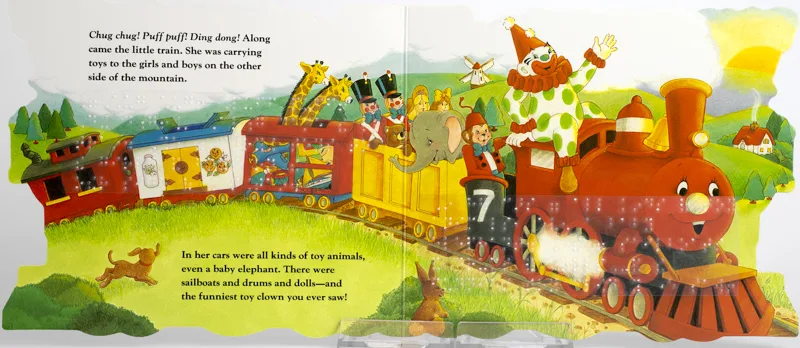
Write For Readability
A book that’s fun to read is a book that kids will want to revisit. By playing with sound, pacing, and sentence structure, you will be able to create a rhythm that feels effortless and enjoyable.
Use tools like Hemingway Editor or Grammarly, which help improve sentence structure, grammar, and readability.
A children’s storybook needs to sound natural when spoken aloud. Read it to test its rhythm and flow. Hearing your words can reveal awkward phrasing or clunky sentences that might not work well for young readers.
Vary Your Sentence Structure
Mixing short, punchy sentences with longer, flowing ones adds variety and a natural rhythm to the text. A combination of sentence lengths creates a cadence that enhances readability and keeps children interested.
By selecting your writing style and fine-tuning the language, tone, and rhythm, you can create a story that captures and holds the attention of young readers.
4. Incorporate Key Elements
As you work through the entire process of creating a children’s book, understanding the key ingredients that make a story unforgettable can make all the difference. A powerful story idea is only the beginning—you need to weave together characters, dialogue, and emotion in a way that feels authentic to young readers.
Here are some essential elements to build a book that kids and parents will appreciate.
Dialogue That Sounds Natural
Dialogue brings your story to life. Think about the stories your own kids love. Children recognize when conversations feel real—capturing the rhythms and phrases they hear every day is essential.
Including realistic, age-appropriate dialogue shows you truly understand your audience and earns their trust—and often, their kind words when they fall in love with the story.
A Storyline Full of Adventure and Emotion
A great children’s book follows a meaningful path where characters face challenges and grow. From the first page to the last, obstacles keep readers turning pages. Additionally, children love characters who mirror their dreams, fears, and everyday experiences.
Whether you’re creating a simple picture book or a sweeping chapter book, designing a journey with both excitement and heart is just what young readers crave.
5. Create Unforgettable Characters
Great children’s book characters are memorable, relatable, and unique—the kind that lingers in readers’ minds long after the book is closed.
Think of The Cat in the Hat, whose playful rhymes and mischievous charm make every page exciting, or Paddington Bear, whose good intentions and knack for chaos make him endlessly endearing.
These characters resonate because they reflect real emotions, struggles, and growth—whether it’s facing fears, making friends, or learning an important lesson.
Character Development Checklist
A strong character has depth, purpose, and a journey readers can connect with. When developing your character, check off the following questions:
What do they want? – Every great character has a goal that drives their actions.
What’s stopping them? – Obstacles, whether internal (self-doubt) or external (a tricky villain), add tension and stakes.
What makes them stand out? – A quirky habit, a signature look, or a distinct way of speaking sets them apart.
How do they change? – Growth is key—this can include learning to be brave, kind, or confident.
It could be a shy bunny learning to speak up or a mischievous monkey discovering the value of honesty; strong character arcs are crucial to the story. These personal journeys help young readers understand that growth is possible, both for the characters and themselves.
Making Characters Stand Out
A defining trait can make a character instantly recognizable. Pippi Longstockings’ wild red braids and mismatched stockings are as unforgettable as her fearless attitude.
Dialogue plays a huge role, too—whether it’s rhyming speech, a signature catchphrase, or made-up words, the way a character talks adds depth and personality.
By giving your characters clear goals, personal growth, and a touch of the unexpected, you create figures that don’t just tell a story—they stay with readers for a lifetime.
6. Blend the Components into a Cohesive Story
Creating a captivating children’s book is about weaving these components into a story. The characters, dialogue, storyline, and action all need to interact and build upon each other. Stories typically begin with the characters, but they can’t come to life without meaningful dialogue.
Dialogue, in turn, shapes the progression of the storyline. In Where the Wild Things Are by Maurice Sendak, Max’s interactions with the Wild Things develop his journey, building tension and excitement while furthering the plot. As the story builds, the characters and their interactions create a sense of momentum that propels the story from one scene to the next.
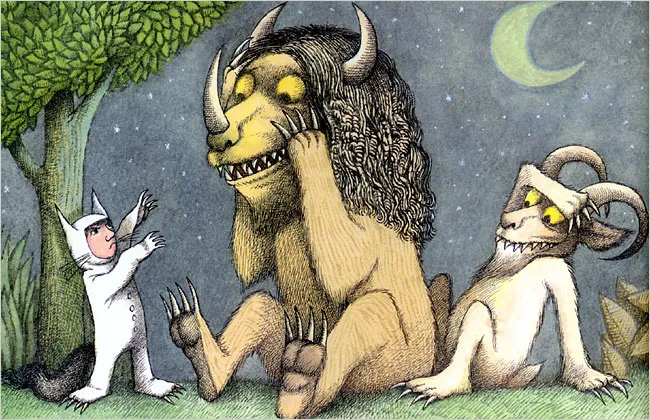
In Charlie and the Chocolate Factory, a middle-grade book by Roald Dahl, the story kicks off with Charlie receiving the golden ticket, which sets him on an exciting journey into the mysterious and magical world of Willy Wonka’s chocolate factory.
Whether it’s a burst of excitement or a quieter emotional moment, the action needs to be relevant to the themes of the book.
Ultimately, the magic happens when these elements work together, each one supporting and enhancing the other. When the character’s goals align with the plot, and the dialogue feels natural, the result is a cohesive story that feels whole and connected.
7. Decide on a Book Title
The title of your children’s book is one of the first things potential readers will encounter, so make it impactful. A great title is catchy, intriguing, and gives readers a sense of what the story is about.
Your title is what encourages readers to explore the pages inside. For example, Harry Potter and the Chamber of Secrets by J.K. Rowling hints at mystery and adventure.
When brainstorming potential titles, think about the themes, characters, and emotions that define your story. What feeling do you want to evoke in the reader? Consider how the title connects with both children and parents.
For example, The Giving Tree by Shel Silverstein connects deeply with both kids and adults because of its universal themes of love and sacrifice. Pete the Cat: I Love My White Shoes by Eric Litwin is playful and simple.
Get feedback from friends, family, or even writing groups to see which title resonates most with people who represent your target audience.
4 Do’s When Writing a Children’s Book Title
Use Alliteration. Titles like Big Red Barn or Froggy Gets Dressed are fun to say, memorable, and help children connect with the story. The rhythmic repetition makes them easy to recall.
Ask a Question. A title that poses a question, like What If…? (by Samantha Berger), piques curiosity and invites readers to seek the answer within the pages.
Incorporate Humor. Titles like The Book with No Pictures by B.J. Novak play with expectations and the humor within the book's content.
Be Cautious with Puns and Wordplay. While clever puns and wordplay often amuse adults, they don’t always resonate with young readers.
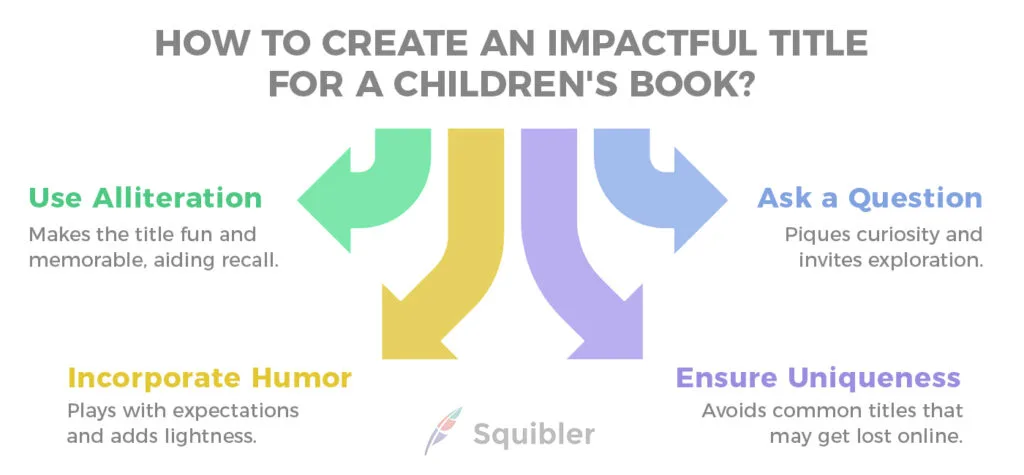
Lastly, conduct a quick online search to ensure your title isn’t already widely used. A title that’s too common might get lost among others, so aim for something distinctive and relevant to the content of your book.
If you need help coming up with a title, Squibler’s Children’s Book Title Generator can assist.
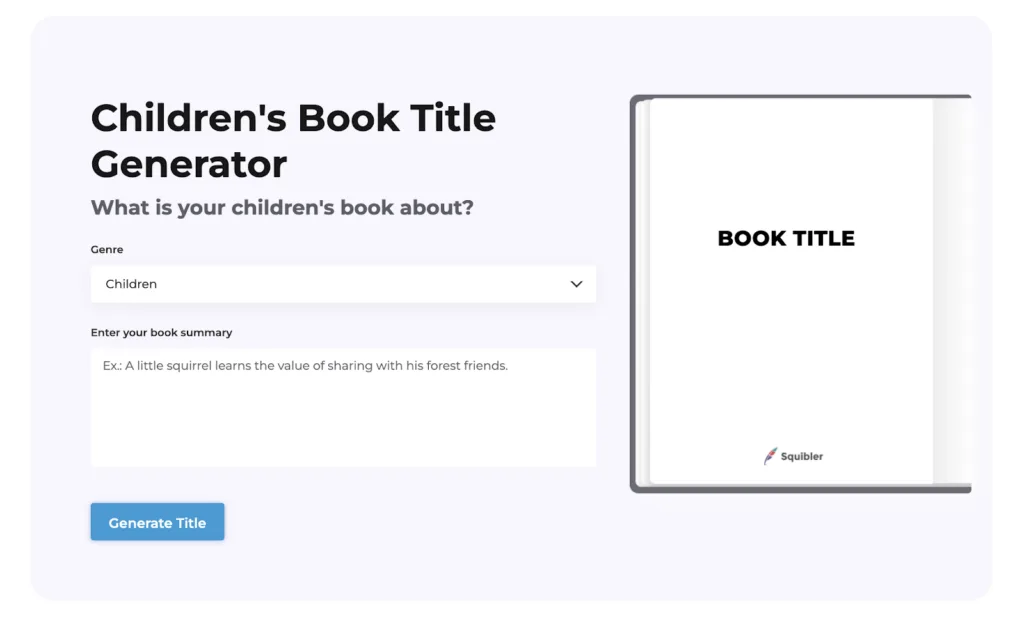
8. Find an Illustrator and Editor
In children’s books, illustrations are more than just decorations—they are an integral part of the storytelling process. Whether you’re working on a picture book, or a chapter book, the right visuals can bring your narrative to life.
Think about The Very Hungry Caterpillar by Eric Carle, where the simple illustrations match the book’s gentle tone. The ideal illustrator for your book will complement the themes and characters, creating artwork that aligns with the narrative's mood and pace.
Finding the Right Illustrator
When seeking an illustrator, research their artistic style and experience with children’s books. Ensure they understand the target age group you’re writing for and can create illustrations that resonate with them.
Be transparent about your expectations, budget, timelines, and the revision process. The relationship between the author and the illustrator is key—open communication can help bring your vision to life and ensure the final product meets your standards.
Behance and Dribble are great starting points for exploring illustrator portfolios. For more affordable options, Fiverr and Upwork provide a range of illustrators at different price points. If you’re confident in your art skills, illustrating the book yourself is another option.
After securing your illustrator, get an editor to revise your work before the drawing briefs are finalized.
Finding an Editor
After writing your own book and completing several rounds of self-editing, input from beta readers can provide valuable insights. However, the final version still deserves the attention of a professional editor.
Whether you’re writing children’s books inspired by a fun idea or real life, a professional editor can help refine your story elements, ensure your main character takes center stage, and make your book shine for its target audience.
There are several types of editing to consider.
Developmental editors assess the overall structure, pacing, character development, and whether the content is age-appropriate. For children’s books, this ensures that the story is engaging and understandable for the targeted age group.
Copy editors focus on grammar, sentence structure, and clarity, adjusting the language to suit the developmental stage of your audience.
Finally, proofreaders catch minor errors—spelling, punctuation, and formatting mistakes—before your book is ready for publication.
Finding an editor can be done through platforms like Upwork or BookBaby, which allow you to compare different professionals and get quotes.
You can also turn to organizations like SCBWI (Society of Children’s Book Writers and Illustrators) or the Editorial Freelancers Association, which offers directories of qualified editors.
Understand Legal Agreements and Copyrights
When hiring an illustrator or editor, it’s essential to have clear legal agreements in place. In children’s publishing, “work-for-hire” contracts are standard—these ensure that you, the author or publisher, retain full rights to the artwork or edited material.
Without a proper agreement, the illustrator may legally own the images, which could limit how you use or distribute your book. Always clarify copyright ownership, licensing rights, and payment terms upfront to avoid future conflicts.
Consulting a legal professional or using trusted contract templates specific to publishing can also protect your project.
9. Create a Book Dummy
A book dummy is a rough first draft of your book in physical form. It helps you visualize how the text and illustrations will flow from page to page. This is especially important for picture books, where the balance between words and illustrations plays a critical role in storytelling. Think of it like a sneak peek of the final product—before you commit to anything permanent.
To make a book dummy, start by folding sheets of paper to match the number of pages in your book. Number the pages and lightly sketch rough illustrations or placeholders to represent image placement.
Write or paste your text into each page, considering how much should appear before a reader turns to the next spread.

As you flip through the dummy, pay attention to the rhythm of your story—do key moments land on impactful page turns? Does the pacing hold a reader’s interest? Adjust as needed, shifting text and imagery until the sequence feels natural. Digital tools like Canva or Adobe InDesign can also be useful for creating a virtual book dummy.
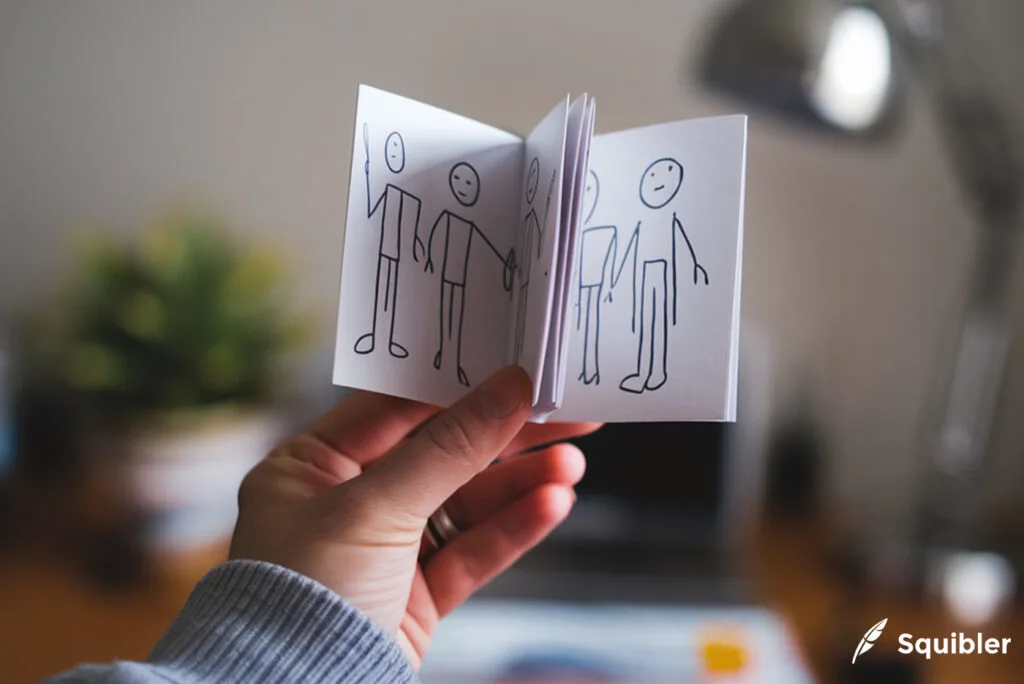
Even if you have a strong vision for your book, a dummy provides valuable insight into how everything comes together in physical form. Many successful children’s book creators use dummies as a standard part of their process.
Taking the time to create one can help prevent costly revisions later.
10. Publish Your Book
After completing your book, you’ll need to decide whether to pursue traditional publishing or self-publishing. Each route has its benefits and challenges, so it’s important to evaluate your goals, budget, and how much creative control you want over the process.
Traditional Publishing
Traditional means of publishing involves submitting your manuscript to established publishing companies like Penguin Random House, HarperCollins, or Simon & Schuster. If your book is accepted, the publisher handles everything—from editing and cover design to marketing and distribution.
This path requires no upfront costs, provides access to industry experts, and offers wider bookstore and library distribution. However, the process is highly competitive, with publishers receiving thousands of submissions and accepting only a fraction. If you secure a deal, you’ll have less creative control, as publishers make the final decisions on key elements like illustrations and pricing.
Additionally, the traditional route is a slow process, often taking over a year from acceptance to release, and authors typically earn lower royalties, with a percentage going to literary agents if they have one.
Many beloved children’s books, such as The Very Hungry Caterpillar by Eric Carle and Where the Wild Things Are by Maurice Sendak, were published through this route.
Self-Publishing
Self-publishing, on the other hand, gives you full creative control and the ability to publish on your terms. Platforms like Amazon Kindle Direct Publishing (KDP), IngramSpark, and Barnes & Noble Press allow authors to release their books without waiting for approval from a publishing house.
Self-published authors can earn higher royalties—up to 70% of book sales—compared to the 5–15% typically offered when publishing traditionally.
The process is also much faster; instead of waiting months or years, you can publish in a matter of weeks. However, self-publishing comes with its own set of challenges. You’ll need to cover upfront costs for editing, illustrations, and formatting to ensure a high-quality book.
However, without an established platform or audience, self-published children’s books often face limited access to physical bookstores and libraries. Also, building visibility and driving discovery largely depends on the author’s own marketing efforts.
Still, self-publishing success stories exist—books like P is for Pterodactyl by Raj Haldar and The Rabbit Who Wants to Fall Asleep by Carl-Johan Forssén Ehrlin became bestsellers through this route.

When publishing a children’s book, you can choose between traditional means and doing it yourself. Weighing factors like budget, creative freedom, and marketing responsibilities will help determine the best path for your book.
Tips for Writing your Children’s Book
The difference between a good children’s book and a great one is all in the details. Here are a few key tips to help yours stand out.
Infuse Age-Appropriate Humor and Playfulness
When you start writing, think about what will genuinely make kids giggle. Silly words, funny situations, and playful interactions between the main character and others can turn an idea into a unique story that kids want to hear again and again.
Focus on a Strong Story Idea and Inciting Incident
A new writer might not realize how important the inciting incident is for kids books. In the first week of your writing journey, brainstorm not just a book idea and the main characters, but also a surprising event that sets the whole story in motion.
Understand Your Own Preferences and Your Audience
It’s worth noting that when writing your first children’s book, you should consider both your preferences and the interests of your intended audience. A blog post discussing kids’ favorite books can offer valuable insights into creating a children’s book that resonates.
Final Thoughts
Crafting a children’s book requires creativity, structure, and attention to detail. From developing engaging characters to finding the right illustrator, each step plays a role in bringing your vision to life.
Whether your book makes children laugh or teaches an important lesson, the journey to creating a book is an endeavor that can leave a lasting impression on readers. Now, it’s time to take the next step and put your pen to paper.
Ready to bring your story to life? With Squibler, you can streamline the writing process, generate ideas, and structure your book effortlessly. Whether you’re crafting a picture book or a middle-grade adventure, Squibler’s tools help you stay organized and inspired.
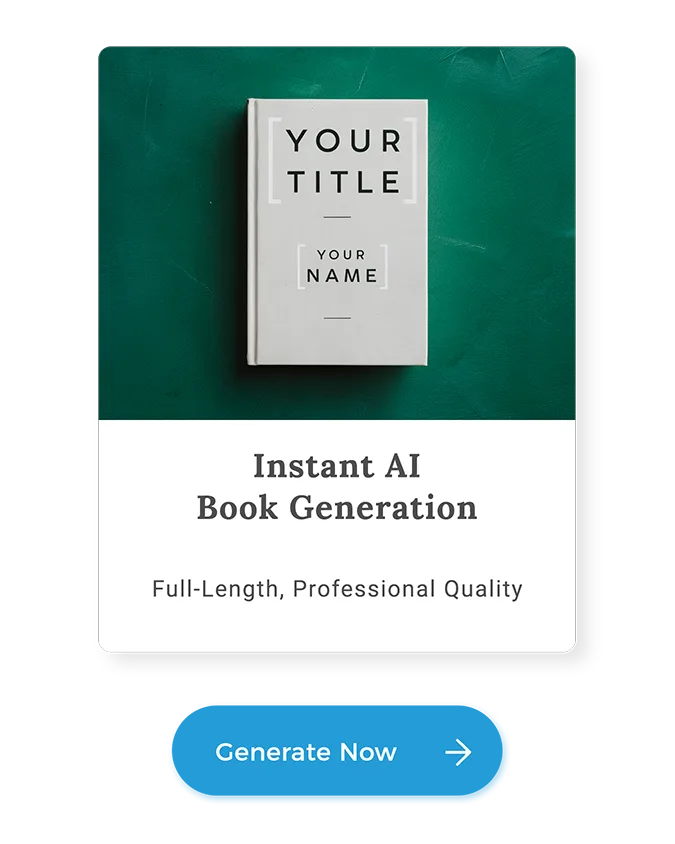
Looking for free templates, check out this site for some great children’s book templates.
FAQs
Here are answers to the questions regarding how to write a children’s book:
Is it hard to write children’s books?
Yes, writing a children’s book can be challenging. Authors must consider their audience’s developmental stage, ensuring themes and characters resonate with the target age group.
They must also strike a balance between simplicity and depth, and craft a story that is engaging both in narrative and visual appeal.
How many pages should a children’s book have?
Page count varies by book type. Picture books typically have 32 pages, while board books are shorter, ranging from 10 to 24 pages. Chapter books generally fall between 32 and 100 pages.
How long does it take to write a kid’s book?
The timeline for writing a children’s book varies depending on factors like how complex the story is, the author’s experience, and the age group you’re writing for.
A picture book might only take a few weeks to draft, while a more detailed story could take several months. But with Squibler, you can get started right away–whether you’re creating an outline or writing a whole story.
How much does it cost to print a children’s book?
Printing costs depend on factors such as page count, print run size, and printing method (digital or offset). For example, a 32-page children’s book might cost $3–$7 per unit for a print run of 250 copies, with costs decreasing for larger print runs—around $2.05 per unit for 2,500 copies.
Additional expenses include paper quality, color printing, and binding options.
